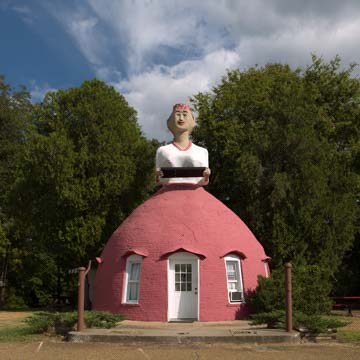Mammy’s Cupboard dates to a time when automotive tourism was booming and visual gimmickry lured motorists off the road and into shops and restaurants. This depiction of an enslaved African American “mammy” is rooted in the endemic racism of the time and the popular culture stereotypes of the antebellum South. The mimetic restaurant, found just south of Natchez, is still a prominent fixture on the Great River Road, which runs from Minnesota to New Orleans.
Although Southern in origin, the Mammy stereotype was well known to Northerners through earlier kerchiefed incarnations including Bill Kersand’s 1870s minstrel song “Aunt Jemima” and the figurehead on Aunt Jemima pancake mix that had debuted at the 1893 Chicago’s World’s Columbian Exposition. Enthusiasm and curiosity about the “old South” were being both created and catered to when Natchez inaugurated its annual tour of antebellum mansions in 1932; the apogee of the fad arrived in 1939, when the film version of Margaret Mitchell’s 1936 book Gone With the Wind debuted in movie theaters. Henry Gaude’s Shell service station capitalized on the stereotype of the enslaved but respected African American nursemaid as portrayed onscreen by Hattie McDaniel, who won an Academy Award for her acting.
Annie Davis Bost (1880–1967), wife and occasional assistant to Natchez architect Robert Edgar Bost, sketched out the service station for Henry Gaude on a piece of brown paper, apparently never bothering to make architectural drawings. The entire structure stands 28 feet high, with Mammy’s 20-foot-diameter hoop skirt constructed entirely of salvaged bricks. These bricks, along with the 14-inch-square cypress beams that support Mammy’s concrete torso, were repurposed from a local cotton gin that had been demolished. Sash windows with simple sheet-metal hoods are placed symmetrically to either side of the centrally placed front door and around the periphery of the skirt; several of the original windows were infilled at an unknown date. The entire skirt has always been painted red, although the exact shade has changed multiple times. Mammy’s upper body is made of concrete and stucco over a wire mesh and wood core that has required periodic maintenance and even the replacement of lost appendages. Mammy offers a tray in her outstretched arms. Mammy’s skin color was originally dark brown or black but has been increasingly lightened since at least the 1960s. She is portrayed wearing hoop earrings made from horseshoes and a red polka-dotted kerchief on her head in addition to another plain red one around her neck. The interior is a single open room with a dropped ceiling. The simple, box-shaped frame kitchen and restroom that are attached at the rear of the hoop skirt are discretely hidden by large trees.
Wilma Gaude originally sold baked goods to customers who stopped at her husband’s gasoline station. While the pumps are long gone, the current tenant again offers pies and other home goods to curious automotive tourists from inside Mammy’s bell-shaped hoop skirt. According to local lore, attempts to list Mammy’s Cupboard on the National Register of Historic Places and to designate it a Mississippi state historic place have repeatedly been blocked because of the building’s obvious racist imagery.
References
Andrews, J. J. C. The Well-Built Elephant and Other Roadside Attractions: A Tribute to American Eccentricity. 1st ed. New York: Congdon and Weed, 1984.
Butko, Brian, and Sarah Butko. Roadside Giants. Mechanicsburg, PA: Stackpole Books, 2014.














